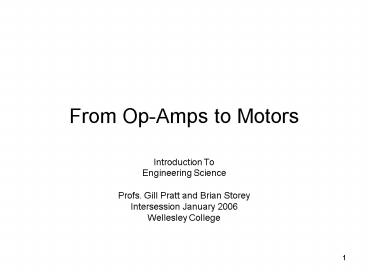From OpAmps to Motors
1 / 30
Title: From OpAmps to Motors
1
From Op-Amps to Motors
- Introduction To
- Engineering Science
- Profs. Gill Pratt and Brian Storey
- Intersession January 2006
- Wellesley College
2
What This Course is All AboutFour Central Ideas
of Engineering
- The Dual Variables of Effort and Flow
- how power flows between interacting objects,
regardless of their domain (e.g. Electrical,
Mechanical, Thermal, Biological, etc). - State
- how systems remember the past, and which results
from the time integration and storage of energy. - Transduction
- the bidirectional transformation of effort and
flow from one domain to another. - Feedback
- used in almost all engineered devices to bring
about desired behavior despite undesired
disturbances.
3
Who is this guy?
4
The OPA551 Op-Amp
5
A Zero-Order Model of Op-Amps
Forklift
Left Eye Negative Input Right Eye Positive
Input Actuates Biceps if Right Eye gt Left
Eye Actuates Triceps if Left Eye gt Right
Eye Rate of Arm Motion Proportional
to Difference eyes see Proportionality Constant
is very High Eyes Dont Disturb what they look
at Due to buff build, arms cant extend or
contract all the way
6
Our first Model of an Op-Amp
7
VerifyingOpen Loop Characteristics
- Experiment with op-amp open-loop
8
Output Saturation
9
Our second Model of an Op-Amp
10
Finite Slew Rate
11
Our final Model of an Op-Amp
Next Time Flattening out at Low
Frequencies Feedback
12
The Simplest FeedbackThe Follower
13
Experiment with the Follower
14
What does this teach us?
- Output of follower converges to input
- Output of follower resists disturbances
- Op-Amps Behavior
- Trys to move output to get inputs to agree
- Eventually, inputs agree (almost perfectly)
15
The Op-Amp Follower
Why is This a Useful Circuit?
The Difference Between Forklifts Eyes and Arms
Power Steering in Cars and Ships
16
How about this one?
17
Using Op-amps for Gain
What are these?
18
Effort and FlowAcross and Through
Flow (Through)
Effort (Across)
19
Some Effort and Flow Analogs
20
Resistance(Real Impedance)
21
Electrical Resistance(Real Impedance)
Q What is I ?
A V over R !
22
Using Op-amps for Gain
Rtotal 2 R
V Out / 2
I Out / (2 R)
23
The ElectromagneticTransform
Mechanical
Electrical
Current I
t Torque
Voltage V
w Speed
I V
t w
Is this really lossless?
24
DC Motor Model
25
Motor Driver Circuit
26
Computer Output Controls Motor Current
- Bottom op-amp keeps junction of Rckt and Motor at
0 volts (vitual ground) without drawing current
from this node. - Computer Outputs a voltage Vpcout
- Top Op-amp forces Vpcout to appear across a known
resistor Rckt 24 Ohms - Voltage V across R generates current
- IRckt Vpcout / Rckt
- All current I going through R also goes through
motor. - Thus, motor current Imtr Vpcout / Rckt
- How should we command desired torque?
- Vpcout Rckt tdesired / Kmtr
27
Motor Driver Circuit
28
Motor Voltage is read into computerMotor Current
is read into computer
- Motor Voltage reading is straight
- Motor Current reading is multiplied by Rckt to
create a voltage for the A/D - How do we figure out w from motor voltage?
- Vemf Vmtr Imtr Rmtr
- w Vemf / Kmtr
29
What we can now do
- Command Motor Torque
- by commanding desired motor current Imtr_cmd 24
- Check if we got torque we asked for
- by checking actual motor current Imtr_act 24
- Measure motor speed
- by measuring motor voltage Vmtr and
- subtracting Imtr Rmtr drop of motor resistance
30
Build Motor Driver Circuit
- Experiment driving motor current 24 command
with signal generator - Connect scope to
- actuator motor current 24 signal
- actual motor voltage
- Try zero current command
- Spin motor and see what you get on scope
- Add channel 1 and channel 2 with scope math
- Result is Vemf (proportionate to motor
velocity) - Try sine waves of varying frequency
- See F ma in action































